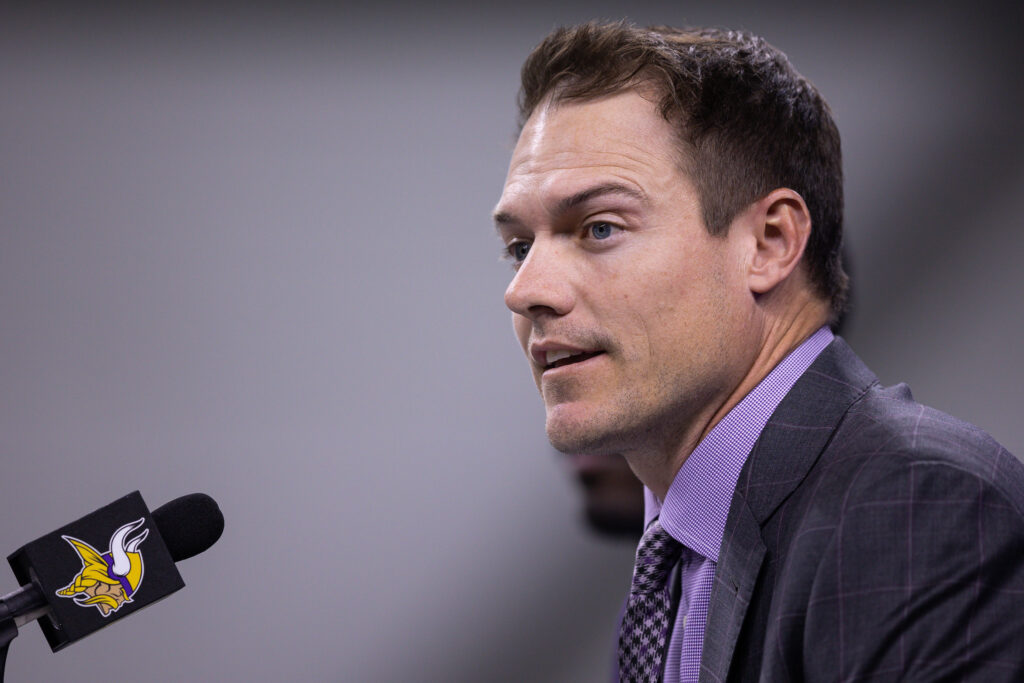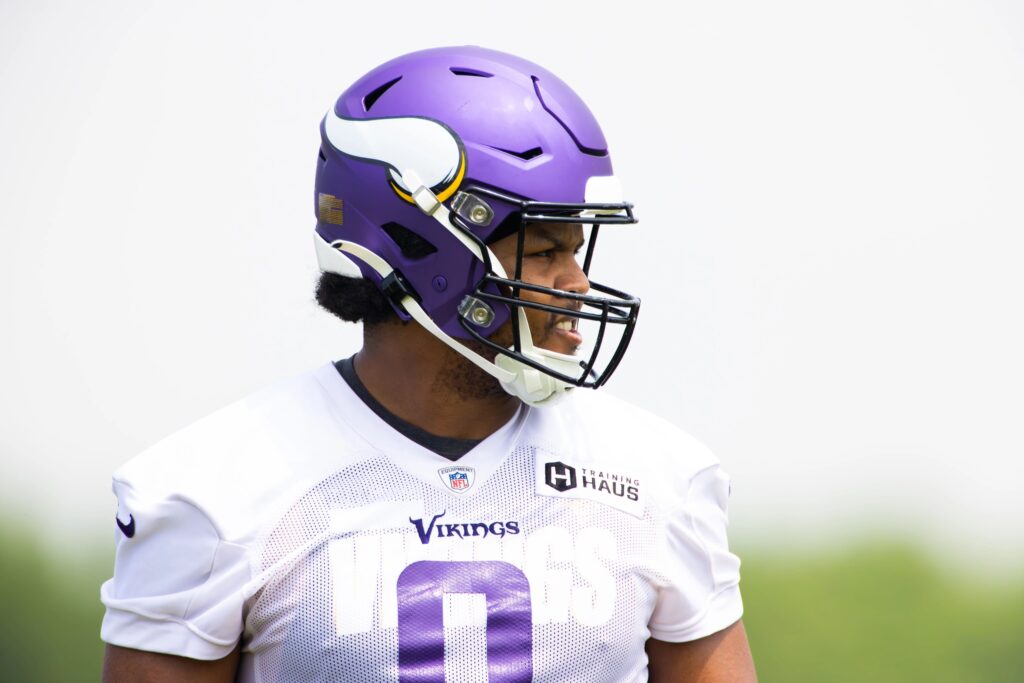There hasn’t been a blank canvas in Minnesota in a long time.
Since Mike Zimmer found quick success taking a broken down team in 2013 to a division winner in 2015, the Vikings have been in the mode to compete for the playoffs every year. The front office and coaching staff took on a pedal-to-the-metal, make-or-break, go-until-the-wheels-come-off approach to every offseason, focusing most on the final pieces to get over the top.
Think about some of the moves they made during that time that pointed to an all-in approach. Trading for Sam Bradford after Teddy Bridgewater got hurt. Signing Kirk Cousins to the most guaranteed money in history. Trading for Yannick Ngakoue. Signing seven new starters on defense. Drafting for need with nearly every top-three round pick, including two running backs and two centers since 2017.
Now as we enter a new era it’s unclear how Kwesi Adofo-Mensah and Kevin O’Connell will approach the timeline, the roster and the coaching philosophy.
We can look for clues though.
O’Connell’s extensive opening press conference covered a lot of ground about his plans, so let’s try to read in between the lines and paint a best-guess picture of what the Vikings will look like in the coming years…
Of course, our sleuthing starts with the quarterback.
The Vikings’ new head coach answered two questions about Kirk Cousins. Both answers read as if O’Connell is preparing to coach Cousins this year.
“I know who he is as a player and what he’s capable of, and part of our job as coaches is maximizing a player’s ability to go out every single Sunday and have success,” O’Connell said in his first answer.
The new head coach’s remark suggests that the main focus of the offensive scheme will be supporting Cousins’ strengths if he is under center in 2022. Not that previous offensive coordinators completely failed — Cousins posted career bests while playing for Kevin Stefanski and Gary Kubiak — but he often seemed like an inconvenience to Mike Zimmer rather than an asset.
Still, there seems to be some double talk in saying that he knows who Cousins is and what he’s capable of. We could take that as a hint that O’Connell thinks Cousins is capable of much more or that he knows the limitations of the Vikings’ veteran QB. O’Connell coached Cousins in 2017, which was his lowest graded season by PFF and lowest QB rating as a starter.
“I know he’s already contract and I’m excited to coach him,” O’Connell responded to a follow-up Cousins question. “We’ve already started thinking about how we’re going to build those systems for him and our other quarterbacks and really the tremendous skill group that we have, our guys up front. It takes all 11 to move the football on offense, to run it, to throw it, to score points in the red zone. But I’m anticipating Kirk being a part of what we do.”
Saying that someone is under contract isn’t the same as saying you want them to be under contract with your team for the rest of eternity, which you might have heard if O’Connell was taking over a team with Patrick Mahomes at quarterback.
Can we already boil the Vikings’ options with Cousins down to two avenues: Staying on his current contract (with the possibility of void years to reduce his cap hit) or being traded?
A contract extension can’t entirely be ruled out but there was nothing in O’Connell’s answers that even hinted at Cousins as the long-term answer. Combine that with the rumor mill buzz of late suggesting that Cousins won’t sign a team-friendly deal and would rather play out his contract and we can make an educated guess that the team’s future at QB will be someone they draft.
Will it be this year? Next year? Would they want a bridge quarterback? Do they think this year’s QB draft class is weak? Would they prefer that a rookie sits for a year? Do they have a rabbit to pull out of a hat in the form of a trade for another quarterback that we don’t see coming? None of those things were implied in O’Connell’s press conference.
Alright, moving on.
How much does O’Connell want the Vikings to become Rams North? His replies strongly indicate that’s the case. Here’s what he said when asked about calling plays:
“I feel very prepared to call the game. I feel like I’ve been around one of the best play callers in the NFL over the last couple years, and the system we run here will have a lot of characteristics of what we did in Los Angeles, the ability to have that attacking mindset.”
It’s hard to pin down exactly what an “attacking” mindset means. The first thought is: More deep passing. But the Rams didn’t actually push the ball downfield more than the Vikings. Cousins threw 71 passes more than 20 yards in the air compared to Matthew Stafford’s 67 deep throws (per PFF). However, the Rams did throw significantly more early down passes in the first half of games than the Vikings. Stafford ranked fifth in the NFL in attempts in first or second down early in games, whereas Cousins was 15th, just ahead of Baker Mayfield and Jimmy Garoppolo.
The Rams also went after the intermediate passing game more often by a 24% to 19% margin. Per PFF, a total of 14% of Stafford’s throws were intermediate and attacking the middle of the field. Less than 5% of Cousins’ throws went after the middle of the defense.
O’Connell explained that we won’t see a more complex offense but the Vikings are likely to deploy an offense that’s more difficult to pin down for defenses. Per ESPN’s Seth Walder, the Rams used motion at the snap the fifth most in the NFL and pre-snap motion of any kind more than 50% of the time. The Vikings were 16th in motion usage last year.
“That illusion of complexity where teams think that there’s a lot of offense that they’re defending, but really we’re only doing small details here and there just to change the picture, change angles, give ourselves an advantage wherever we see fit, both in the run game and in the pass game, using tempo as a weapon, things that people have seen our offense do in LA that they will absolutely see our offense do here in Minnesota,” O’Connell said.
Roster construction is likely to change. The Rams already had Cooper Kupp, Robert Woods and Van Jefferson heading into last offseason and then they added DeSean Jackson and drafted Tutu Atwell in the second round. Neither worked out, so the Rams added Odell Beckham Jr. when he became available. Overall, the Rams picked eight receivers or tight ends in the first four rounds between 2016 and 2021. The Vikings picked three (Treadwell, Smith Jr., Jefferson). We may see the Vikings take on a similar mentality as the Rams of continuing to add playmakers even when the top spots are filled.
On the matter of the running game, something didn’t add up for the Vikings in 2021: Dalvin Cook ranked fifth in the NFL in yards per carry among starting RBs but the Vikings finished 28th in Expected Points Added on the ground.
Running at inopportune times and against disadvantageous defenses may have played a role in their struggles. For example, the Vikings’ No. 2 back Alexander Mattison rushed into 8-man fronts on 30% of carries, whereas the Rams’ secondary runner Darrell Henderson had the fourth lowest percentage of carries into loaded boxes at 13% (per NFLNextGen stats).
“We use the term they’re ‘daring us to run it,’” O’Connell said. “We’ve got to be able to do it. We’ve got to be able to move people up front. We’ve got a really, really good running back here that we’ve got to put him in positions to use his skill set and have a lot of success, and I feel really, really good about a plan to do that.”
The Rams did not have a good running game last year with a shortage on talent in the backfield but still produced better Success Rate and EPA/play marks than the Vikings.
On the defensive side, there was some buzz on the interwebs about O’Connell leaving Danielle Hunter out of his comments about new defensive coordinator Ed Donatell’s vision for the defense. It’s hard to know whether there was intent behind that admission or not. Hunter’s contract situation has put his future in question but he isn’t considered a scheme-specific type player. O’Connell noted Donatell’s experience with Vic Fangio’s system but said that they would be mixing up multiple fronts rather than using just the traditional 3-man fronts.
The Vikings’ new head coach name dropped Harrison Smith, Eric Kendricks and Anthony Barr, who is set to become a free agent He called Smith “the perfect player for the defensive structure we want to play from the standpoint of the coverage, how we want to make all things look the same” and said of the linebackers, “there’s ways to use those guys and allow them to play with an attacking mindset while they’re still responsible for the things that they’re responsible for defensively.”
So if we’re painting the picture of how the O’Connell era defense is going to be built, we can surmise that it’s not going to be torn completely to shreds by moving its centerpieces in Smith or Kendricks.
They could, however, consider a different type of defensive line. Last year the Vikings deployed two nose tackles, which seems unlikely in a Donatell system. One thing that Los Angeles and Denver had in common was interior rushers that could cause major problems for the offense. Aaron Donald is the best defensive player of the era — he would be hard to duplicate. But in similar systems players like Cam Heyward, Shelby Harris, Akiem Hicks and Dean Lowry are highly effective interior pass rushers.
That could mean the end for Michael Pierce and a focus on finding more players to create havoc in the middle. It also opens the door for one-dimensional edge rushers, which Zimmer’s defense did not appreciate. The Vikings moving on from Yannick Ngakoue seemed to be connected to his inability to stop the run. Now lighter D-ends and outside linebacker types will be in play.
We should expect more situational players to emerge. The Rams had seven players with more than 200 pass rush snaps last season.
Would that open the door for Barr to return as a pass-rushing outside linebacker? It doesn’t seem likely. His recent injury history and lack of experience rushing from the edge would make it risky for the new regime to invest in him while changing his position.
The Vikings are more apt to load up the secondary.
“Somebody threw out the stat to me the other day, with everybody really living in 11 personnel nowadays, I think depending on the defense you talk to, 81 percent of the time they’re in nickel defense,” O’Connell said.
Lastly, how can we envision O’Connell’s culture?
Certainly every coach comes in with their idealistic version of the perfect locker room in lockstep but he alluded to a key aspect that Vikings players have been missing over the past few years: Having their voices heard.
“It’s a culture built on players and coaches being connected,” he said. “The communication that exists in that building, coach to coach, player to coach, coach to player is second to none, and it provides a platform for everybody to feel they have the ownership of the why.”
We can expect O’Connell, 36, to look for players to lean on the way Sean McVay essentially made star veteran left tackle Andrew Whitworth a player/coach.
“He’s helped me a lot as you’re still getting familiar with how to best handle this role and navigate through the things that occur on a daily basis,” McVay said of Whitworth in 2019.
So in O’Connell’s first press conference, we got a vision of the way he wants things to be during his tenure in Minnesota and bread crumbs to follow about the offense, defense and culture. As it plays out, we’ll be comparing his words on Day 1 to the execution of his ideas and whether our best guesses on his plans turn out.









